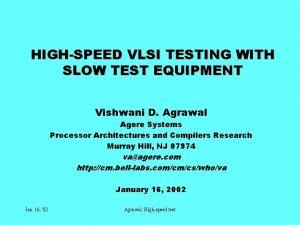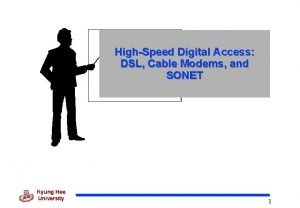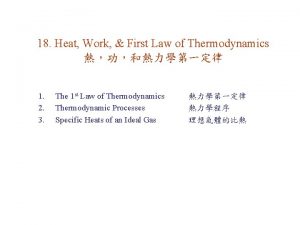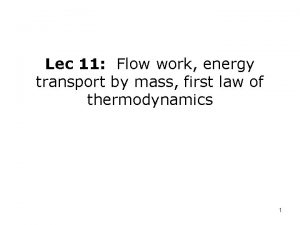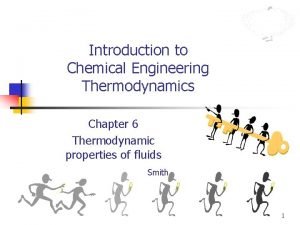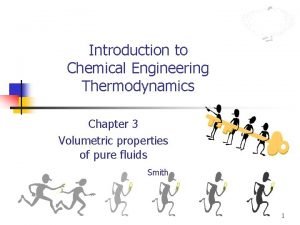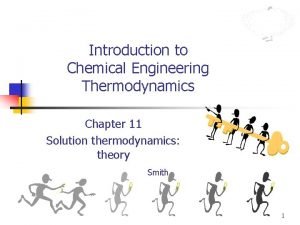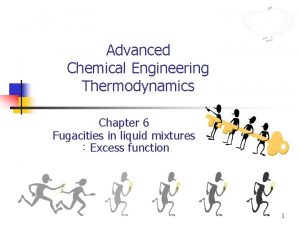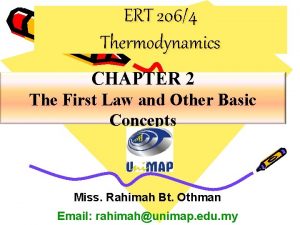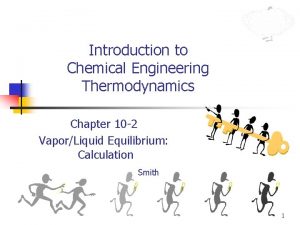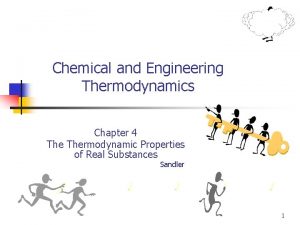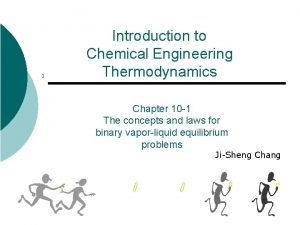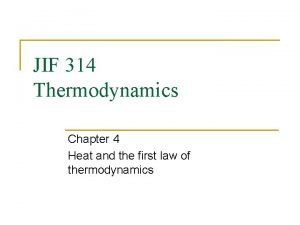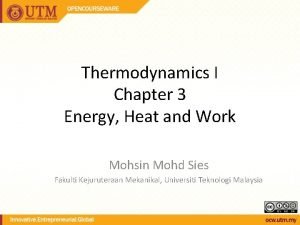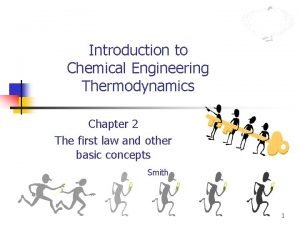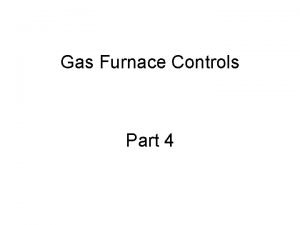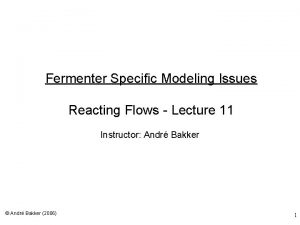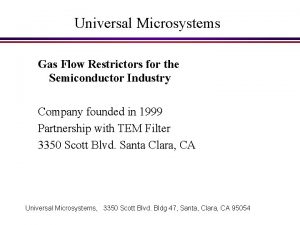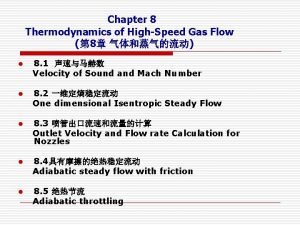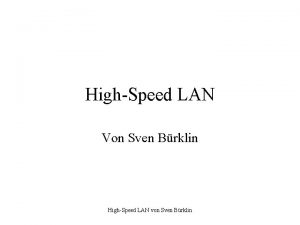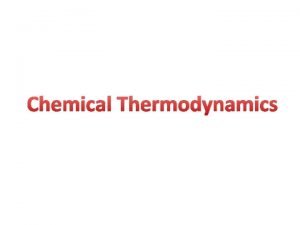Chapter 8 Thermodynamics of HighSpeed Gas Flow 8































- Slides: 31

Chapter 8 Thermodynamics of High-Speed Gas Flow (第 8章 气体和蒸气的流动) l l l 8. 1 声速与马赫数 Velocity of Sound and Mach Number 8. 2 一维定熵稳定流动 One dimensional Isentropic Steady Flow 8. 3 喷管出口流速和流量的计算 Outlet Velocity and Flow rate Calculation for Nozzles 8. 4具有摩擦的绝热稳定流动 Adiabatic steady flow with friction 8. 5 绝热节流 Adiabatic throttling

8. 1 声速与马赫数 Velocity of Sound and Mach Number 1. Velocity of Sound (or Sonic Velocity) (声 速) It is the velocity at which infinitesimally small pressure wave travels through a medium. For adiabatic process For Ideal Gas (对于理想气体)

2. Mach number (马赫数) 定义:流体某一点的运动速度和该点当地声速之比, 以M 表示 Definition: The Mach number, M, is the ratio of the flow speed, c, to the velocity of sound in the same fluid at the same state. It is denoted as M. Varieties of flow (流动的种类) M<1 subsonic flow (亚声速流) M=1 sonic flow (声速流) transonic flow (临界流) M>1 supersonic flow (超声速流) M>>1 hypersonic

8. 2一维定熵稳定流动) One dimensional Isentropic Steady Flow 1. Physical Problem (物理问题) (1) Gas steady flow 气体的稳定流动 (2)The flow in short duct with variable cross-sectional area 变截面短管中的流动 (3)The process is isentropic, that is, reversible adiabatic process 可逆绝热的流动过程,即定熵流动

2. Mathematical Model (数学模型) For flow in duct with variable cross-sectional area, it is necessary to use differential equations to reveal the relationships between Conservation Equation of Mass (质量守恒方程) Conservation Equation of Energy (能量守恒方程) Equation of State (状态方程) For Ideal Gas (对理想气体) u For Real Gas (对实际气体) Process Equation (过程方程) Equation of Entropy(熵方程)

(1) Continuity Equation (连续性方程) (A) If If adopted; then , c , must be

For incompressible fluid , , (2). Energy Equation (能量方程) 0 0 0

For reversible process (可逆过程) (B) If then (3) Process Equation ; 如果 变大( >0), 则p必减少(dp<0); ; 如果 变小( <0), 则p必变小 (dp>0). For ideal gas(对理想气体) For real gas, k is an empirical constant. (对实际气体来说, k是经验常数)

(C ) Eq. (B)× From Eq. (C)

(D) Substitute Eq. (D) into Eq. (A) Supersonic region Subsonic region

Summary (小结) 喷管(Nozzle): 流体流经管道, 压力降低, 速度升高的管道. 扩压管: 流体流经管道, 速度降低, 压力升高的管道 l l (1)喷管内参数的变化情况: dc>0, dp<0 To accelerate the flow, a converging nozzle must be used at subsonic velocities; 当来流速度是亚音速时, 截面做成渐缩形 the highest velocity can be achieved by converging nozzle is sonic velocity. 渐缩喷管最多可使流速达到音速 a diverging nozzle must be used at supersonic velocities 当来流速度是超音速时, 截面做成渐扩形 a converging-diverging nozzle must be used to accelerate fluid from subsonic to supersonic velocity. 当要求气流从亚音速变成超音速时, 截面做成缩放形

2


3. 喷管中的定熵稳定流动 Isentropic steady flow through nozzles (1) 渐缩喷管中流动的特点 Characteristics of flow through converging nozzle p 1 pb If As flow If , there will be no flow through the nozzle; , also continues , , , and. continues , , as , , but ; it reaches sonic , .

(2)拉伐尔喷管中的流动特征 Characteristic of Flow through converging-diverging nozzle

8. 3 喷管的计算 Calculation on the velocity through nozzle 1. 滞止参数 Stagnation Properties Suppose that our steady flow control volume is a set of streamlines describing the flow up to the nose of a blunt object. 定义: 气体速度为零时的状态称为滞止状态, 该状态的参 数称为滞止参数.

The streamlines are stationary in space, so there is no external work done on the fluid as it flows. If there is also no heat transferred to the flow (adiabatic), then the steady flow energy equation becomes (1)滞止焓和滞止温度 Stagnation Enthalpy and Stagnation Temperature

Stagnation enthalpy represents the enthalpy of a fluid when it is brought to rest adiabatically. . Stagnation temperature is the temperature that the fluid would reach if it were brought to zero speed by a steady, adiabatic process with no external work. Note that for any steady, adiabatic flow with no external work, the stagnation temperature is constant

(2)滞止� 力和滞止比容 Stagnation Pressure and Stagnation Volume Note that for a reversible adiabatic process

2. 气体流速的�算与分析 Calculation and Analysis on flow Velocity (1). Caluclation Equation (�算式 ) For Isentropic flow(�于定�流� )











 Highspeed test
Highspeed test Dsl highspeed
Dsl highspeed Thermodynamics of ideal gases
Thermodynamics of ideal gases Steady flow energy equation thermodynamics
Steady flow energy equation thermodynamics Steady flow process in thermodynamics
Steady flow process in thermodynamics What is flow work in thermodynamics
What is flow work in thermodynamics Ideal gas vs perfect gas
Ideal gas vs perfect gas An ideal gas is an imaginary gas
An ideal gas is an imaginary gas Gas law
Gas law Sutherland's law
Sutherland's law Poisonous gas leaked in bhopal gas tragedy
Poisonous gas leaked in bhopal gas tragedy Gas leaked in bhopal gas tragedy
Gas leaked in bhopal gas tragedy Volume molare
Volume molare Flue gas desulfurisation gas filter
Flue gas desulfurisation gas filter Poisonous gas leaked in bhopal gas tragedy
Poisonous gas leaked in bhopal gas tragedy Difference between ideal gas and real gas
Difference between ideal gas and real gas Contoh soal kinetika kimia orde 1
Contoh soal kinetika kimia orde 1 Gas exchange key events in gas exchange
Gas exchange key events in gas exchange Chapter 6
Chapter 6 Chemical engineering thermodynamics 8th solution chapter 3
Chemical engineering thermodynamics 8th solution chapter 3 Chemical engineering thermodynamics 8th solution chapter 4
Chemical engineering thermodynamics 8th solution chapter 4 Chemical engineering thermodynamics 8th solution chapter 6
Chemical engineering thermodynamics 8th solution chapter 6 Control mass
Control mass Chemical engineering thermodynamics 8th solution chapter 10
Chemical engineering thermodynamics 8th solution chapter 10 Thermodynamics chapter 4
Thermodynamics chapter 4 Chemical engineering thermodynamics 8th solution chapter 10
Chemical engineering thermodynamics 8th solution chapter 10 Heat capacity
Heat capacity Q=w/j
Q=w/j Chemical engineering thermodynamics 8th solution chapter 2
Chemical engineering thermodynamics 8th solution chapter 2 Gas furnace sequence of operation flow chart
Gas furnace sequence of operation flow chart Flow gas fermenter
Flow gas fermenter Gas flow restrictor
Gas flow restrictor
